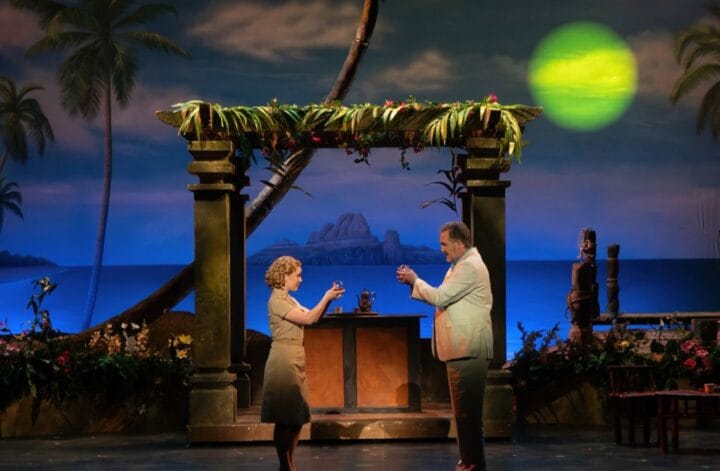“Some enchanted evening, when you find your true love…” For me that enchanted evening took place at the outdoor Jones Beach Theatre in Wantagh, NY. Many, many years ago, when I was 16. And the “true love” that I found was a lifelong passion for live theater (musicals in particular).
South Pacific was only the second musical, or any theatrical performance, I’d ever attended (seeing Mame on Broadway, at age 12, was my first). Both unforgettable – even life-altering – experiences. I guess one couldn’t ask for a more magical venue for an island story like South Pacific than a twilight show that dipped into the gloaming, before lighting up under a starry night . . . where Atlantic ocean waves, at first clearly visible, faded into a murmur of gentle laps stirred by dusk breezes. It’s telling that while I recall attending the show with a few friends, I can’t remember who they were, or even the face of my “date,” if I had one. But I totally remember my feelings of exhilaration in the presence of this wondrous musical!
Fast forward (I won’t say how many years) and I’m given the opportunity to see it again near my now southern home at the Lauderhill Performing Arts Center (LPAC). Where Rodgers & Hammerstein’s oft-described “greatest musical of all time,” SOUTH PACIFIC, is playing through April 27 as the closing show of Broadway at LPAC’s knockout 2025 season.
Should I worry that attempting to repeat a peak moment of my youth won’t live up to expectations or even, god forbid, destroy a perfect memory? I don’t think so. Not when the series’ artistic director and proven, outstanding director/music director Michael Ursua is, once again, at the helm, joined by widely experienced resident choreographer, Alex Jorth. Along with a worthy local cast (many fan-favorite names you’ll recognize), a few incredible imported first-timers, and a dependable creative team.

And what’s not to love when every single song in this musical dramedy went on to become a popular, frequently recorded hit? 1949’s original cast album was the best-selling album of the 1940s. Adding beloved standards not only to musical theater, but to the Great American Songbook. Soon as I name a few, you’ll be humming these unforgettable numbers that range from romantic to haunting, sweet to salty, self-affirming to poignant or hilarious. Perennial hits like: “Some Enchanted Evening,” “Cock-Eyed Optimist,” “Bali Ha’i,” “I’m Gonna Wash That Man Right Outa My Hair,” “You’ve Got to be Carefully Taught.” Not to mention, South Pacific won 10 Tony Awards (including Best Musical, Best Score, and Best Libretto). First to win a Pulitzer for Drama, South Pacific went on to complete 1,925 Broadway performances (closing in 1954 as Broadway’s second-longest-running musical ever; Oklahoma was first). After numerous national and international tours, South Pacific’s 2008 Broadway revival won seven Tonys, including Best Musical Revival.
Director Michael Ursua and producer Kevin Barrett of ACM Theatricals are pumped to bring us this masterpiece. Despite first hitting the stage shortly after WWII – and being written with input from war-experienced Joshua Logan as an adaptation of James A. Michener’s Pulitzer-winning 1947 novel – Ursua argues this “beautiful” story couldn’t be more timely. “There is this panorama of the South Pacific pitted against the narrow-mindedness of bigotry and the horror of the war that was taking place at that time. We see an awakening for some of the characters when they do their own introspection and the whole idea that people are searching for something or running away from something, or better yet, running to something, is fascinating. And the show’s message on racial tolerance is as relevant as anything written before or since.”
South Pacific takes place in an American military outpost in the South Pacific that looks out toward the alluring volcanic island of Bali Ha’i in the distance. WWII also appears to rage in the distance, while warships carrying Navy sailors and nurses arrive in hopes of turning the tide to victory against Japan. Along with natives and Tonkinese, the island has become home to French expats, particularly plantation owners. The curtain rises onto the magnificent, floral decorated plantation patio of sophisticated 44-year-old Frenchman, Emil de Becque. The three-dimensional, solid patio set overlooks an expansive painted mural of sea, sky (with full moon), more palm trees and mist-laden Bali Ha’i.
OK. So while I’m not seated at the beach, like in my first show, thanks to increasingly cool air conditioning (bring a light sweater, especially for Act Two), LPAC’s dusk-descending stage set immerses me in a nautical atmosphere nonetheless. And thanks to scenery provided by Utah Festival Opera & Musical Theatre with wondrous, ever-changing moods, sunlight, and weather conditions created by lighting designer Clifford Spulock backed by Chrystopher Wynter’s sound sound design, the magic prevails.
Except for a clever, looming war-room metallic map (truly a work-of-art), I also appreciate the various painted backgrounds which provide a romantic, 1940’s-era vibe to this classic production. Today’s standard panoramic scenery would use video projections. But as we already have the 1958 film, I was happy to lean into the traditional theatrical experience, enhanced by Penelope Williams’ period-perfect costume design. And, I must admit, LPAC’s seats were a lot more comfortable than those old stadium benches. They also offered good sight lines – from Row H I had a perfect view of the actors’ every expression.
Act One opens to a cheery scene of two half-Polynesian children, siblings Ngana (Emerald Rose Cardenas) and Jerome (Maddox Marquina), playfully running about the terrace of Emil de Becque’s hillside mansion and singing, in French, “Dites Moi” till ushered off by their minder, Henry (Izaiah Scott).

Despite later, heightened war drama and various personal encounters that form a great excuse for entertaining musical numbers (starring natives, the Seabees male Navy sailors and female nurses), at the heart of the musical lies a love story – actually TWO love stories. The primary one contains an obvious conflict, at least at first, by discrepancies in age and cultural backgrounds between a young “hick” nurse from Little Rock, Arkansas and a wealthy, sophisticated 44-year-old French plantation owner. Racial prejudice will later rear its ugly head as well.
The second love story is between a naive, young Tonkinese island girl whose mother had pushed the match and a hunky Marine lieutenant, a Princeton graduate from a prestigious family. Both couples, despite all outward differences, basically fall in love at first sight. Inside their souls, and in their outlooks on life, they are compatible. It’s the externals – especially family and White society’s instilled rejection of those whose skin color is darker than their own – that give them pause. If and how they manage to overcome such early brainwashing is a major source of the musical’s drama. (Shh… Don’t tell the DEI police, or they’ll ban this one too!)
The actors who portray these two couples have plenty of heavy lifting to do, despite additional outstanding numbers by colorful secondary actors. I’ll say right up front that everyone involved in the show comes through with flying colors! Still, I was delighted to see Casey Sacco claim the stage, right after the kids, in the starring role of Ensign Nellie Forbush. It’s a part that appears tailor-made for this triple-threat actor who’s been dominating the South Florida theater scene for some time – especially in the past year. Just when one thinks Sacco is the ideal choice for comedy, or impressed by her vocals, she wows audiences with a serious dramatic role. As Nellie, she also kept me captivated by her fluent southern accent, dance moves (she even did a cartwheel!), bouncy golden curls (if it was a wig, thank you Justin Lore, it really looked like her lovely locks), and perky personality. Not to mention, Sacco’s Nellie is so adorable, it’s easy to see why everyone on the island is taken with her.
Instantly enamored Emile de Becque introduces her to his island paradise home. We eventually discover he’s lived there for 16 years, having escaped France after a fatal fight with a universally despised local bully (he hates bullies). But even before learning all this, Nellie considers some other, more obvious issues that might stand between them, including language barriers (both his English and her French are ongoing sources of amusement). In an exchange where she calls herself “a hick,” and asks if he knows what that means, he responds with, “a hick is someone who lives in a stick.”
But Nellie is wise enough to realize how a person feels inside matters more than externals – even culture and lifestyle. They enjoy each other’s company, they make each other laugh and, most important, both hold enthusiastic attitudes about everyday life. Her insight calls for her to sing the absolutely buoyant “A Cockeyed Optimist,” one of my all-time favorites. And a no-holds-barred attitude adjustment we can all use right about now!
Then debonair Emile de Becque, finely portrayed by Christopher Sanders, proceeds to blow everyone away with his magnificent rendition of “Some Enchanted Evening.” In fact, every time this recently awarded Best Actor in a Musical by Broadway World (and widely celebrated, experienced musical theater pro and Equity member) opens his mouth for a song, it’s a show-stopper. His baritone is incredible, practically operatic – but I like musicals a whole lot more, so am delighted he’s chosen this art form. Another shiver-inducing Sanders’ number is Act Two’s “This Nearly Was Mine.”
My next favorite show-stopping singer, and a great character actor, is Marisol Morales-Dow in the iconic role of Bloody Mary. We first meet her in Scene 2 at another part of the island where she’s set up her souvenir stand featuring hand-woven grass skirts. There she flirts with the young Seabees, beats them in business, yet they celebrate her with “Bloody Mary.” It’s all fun and games until Bloody Mary is star-struck by the arrival of a handsome lieutenant and tries to enchant him with the call of a distant island. Morales-Dow’s “Bali Ha’i” does more than enchant – she overpowers us all by the magnificence of her voice.
I definitely recall the enchantment of “Bali Ha’i.” But the number I’d most often sing to myself, as a kid, was Act Two’s “Happy Talk,” enacted with cute hand motions by Bloody Mary and her beloved daughter, Liat (Thaylin Maria). I’ll have more to say about that relationship later, but for now, let’s agree that “Happy Talk” is an on-point forerunner of today’s “act happy to become happy” self-help axiom. The song even features the repeating motivation stanza: “You got to have a dream, If you don’t have a dream, How you gonna have a dream come true?”




